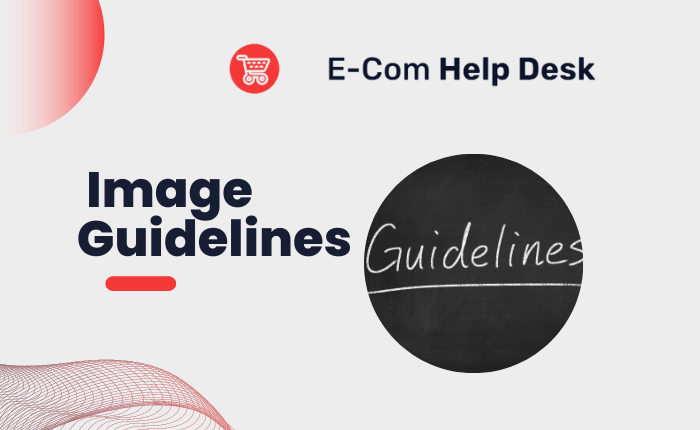Understanding Image Guidelines

Image guidelines refer to a set of instructions or recommendations that provide specific criteria and best practices for creating and using images in various contexts. These guidelines are designed to ensure that images are visually appealing, effective, and appropriate for their intended purpose.
A. Overview of requirements for product images
When it comes to product images, several important requirements need to be met to ensure they meet the necessary standards and effectively showcase the products. These requirements play a crucial role in enhancing the overall customer experience and maintaining consistency across various platforms and marketplaces. To help you navigate these guidelines successfully, let’s delve deeper into the key aspects:
1. Image Quality: One of the fundamental requirements for product images is ensuring high-quality visuals. These images should be clear, sharp, and visually appealing, capturing the essence of the product accurately. A well-crafted image that truly represents the product can significantly influence a customer’s decision to make a purchase.
2. Relevant Content: It is essential to maintain a laser focus on the product itself and avoid any distracting or unrelated elements within the image. The primary objective is to provide potential customers with a clear depiction of what they can expect to receive. You can effectively communicate the product’s features and benefits by eliminating unnecessary clutter and maintaining a cohesive visual representation.
3. Multiple Angles: To provide customers with a comprehensive understanding of the product, it is often beneficial to include images that showcase it from various angles. By presenting multiple perspectives, customers can gain a more accurate perception of the product’s appearance, dimensions, and unique features. This approach fosters transparency and builds trust between the customer and the seller.
4. Contextual Use: In certain instances, contextualizing the product within a relevant setting can be highly advantageous. For instance, if the product is a kitchen appliance, featuring it in a kitchen environment can offer customers a better visualization of how it fits into their daily lives. Contextual images can enhance the customer’s understanding of the product’s utility, functionality, and potential use cases.
B. Image Specifications, including size, resolution, and file formats
Adhering to specific image specifications is crucial to ensure optimal performance, compatibility, and consistent display across different platforms. These specifications encompass various aspects, including:
1. Size: It is important to consider the appropriate size of the product images to strike a balance between quality and loading time. While specific size requirements may vary depending on the platform or marketplace, it is generally recommended to keep file sizes as small as possible without compromising image quality. This ensures that the images load quickly, minimizing any potential delays that could lead to customer frustration.
2. Resolution: The resolution of an image determines its clarity, detail, and overall visual quality. Higher resolutions generally offer better image quality, allowing customers to zoom in and examine the product more closely. However, it is crucial to find a balance, as excessively high resolutions can result in larger file sizes, leading to slower loading times. Strive for a resolution that maintains excellent image quality while keeping the file size reasonable.
3. Aspect Ratio: Maintaining the original aspect ratio of the image is essential to avoid any distortions when displaying it on different devices or platforms. Stretching or compressing the image unnaturally can compromise its visual integrity and adversely impact the customer’s perception of the product. Ensure that the image retains its original proportions to present an accurate representation.
4. File Format: The choice of file format is significant as it determines the image’s compatibility and functionality across various platforms. Some commonly used file formats for product images include JPEG, PNG, and GIF. JPEG is widely supported and provides a good balance between image quality and file size. PNG supports transparency, making it suitable for images that require a transparent background, but it may result in larger file sizes. GIF, on the other hand, is suitable for simple animations or graphics but is not ideal for complex product visuals.
C. Compliance with image policies to ensure visibility
To ensure maximum visibility and reach for your products, it is crucial to comply with image policies set forth by different platforms and marketplaces. These policies are designed to maintain consistency, protect intellectual property rights, and ensure a positive user experience. Here are a few key points to consider:
1. Copyright and Trademarks: When selecting or creating product images, it is imperative to ensure that they do not infringe upon any copyrights or trademarks. It is advisable to use original images or obtain proper permissions if using copyrighted material. Respecting intellectual property rights not only safeguards your business but also fosters trust with customers and other sellers.
2. Offensive or Inappropriate Content: To maintain a professional and inclusive environment, it is essential to avoid using images that contain offensive, explicit, or misleading content. Such content can damage your brand’s reputation and discourage potential customers from engaging with your products. Always adhere to community guidelines and avoid displaying prohibited items or engaging in deceptive practices.
3. Platform-Specific Requirements: Each platform or marketplace may have unique image guidelines and requirements. Familiarize yourself with these guidelines to ensure compliance. These requirements may include specific dimensions, aspect ratios, allowed content, or guidelines on image editing. By adapting your images to meet platform-specific standards, you can maximize your product’s visibility and reach a broader audience.
By understanding and adhering to these image guidelines, you can optimize your product listings, enhance the visibility of your offerings, and provide a seamless browsing experience for potential customers. These guidelines ensure that product images effectively communicate their value and drive engagement, ultimately contributing to your business’s success.
If You have any queries then connect with us at support@legalsuvidha.com or info@ecomhelpdesk.com & you can contact us & stay updated with our latest blogs & articles
